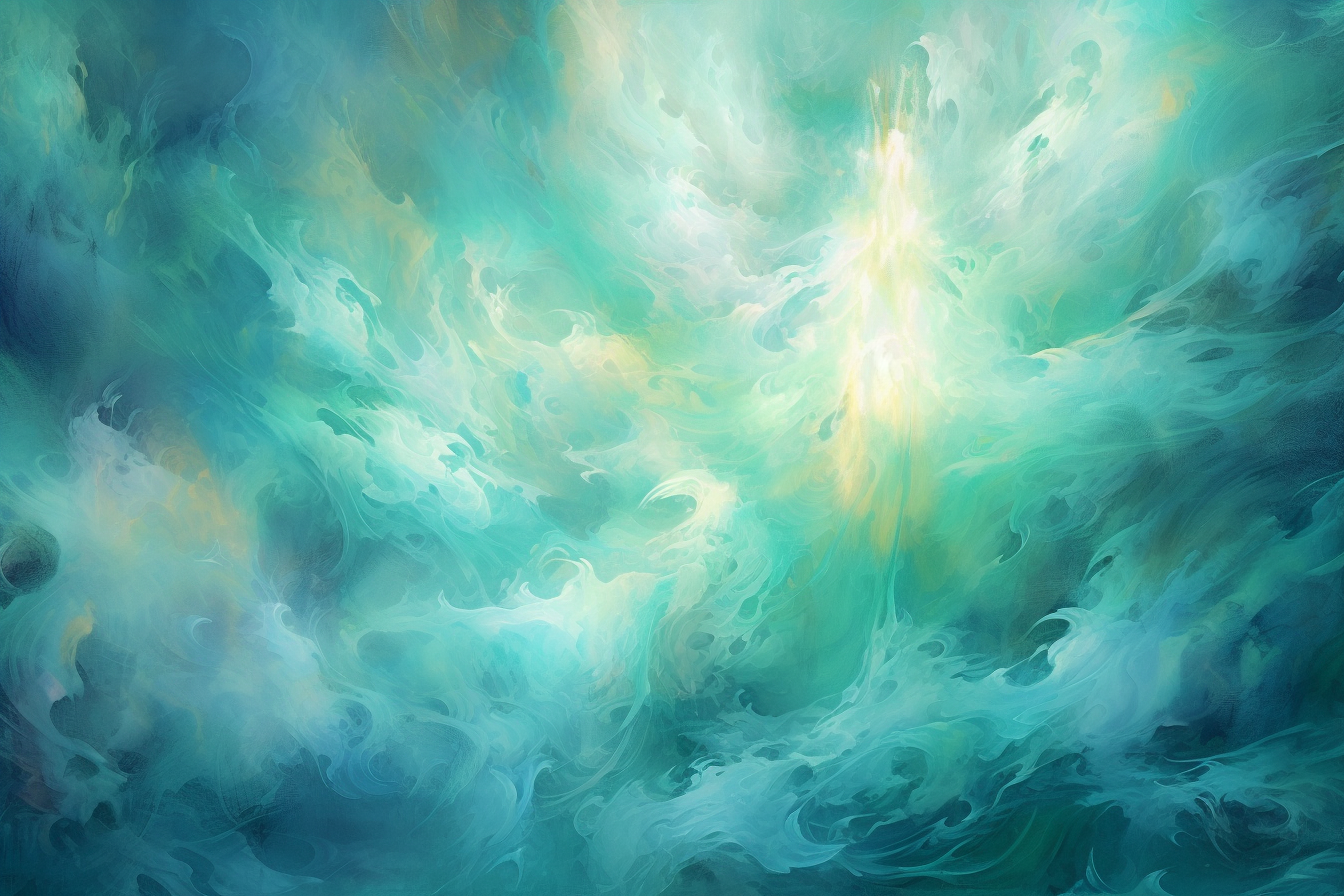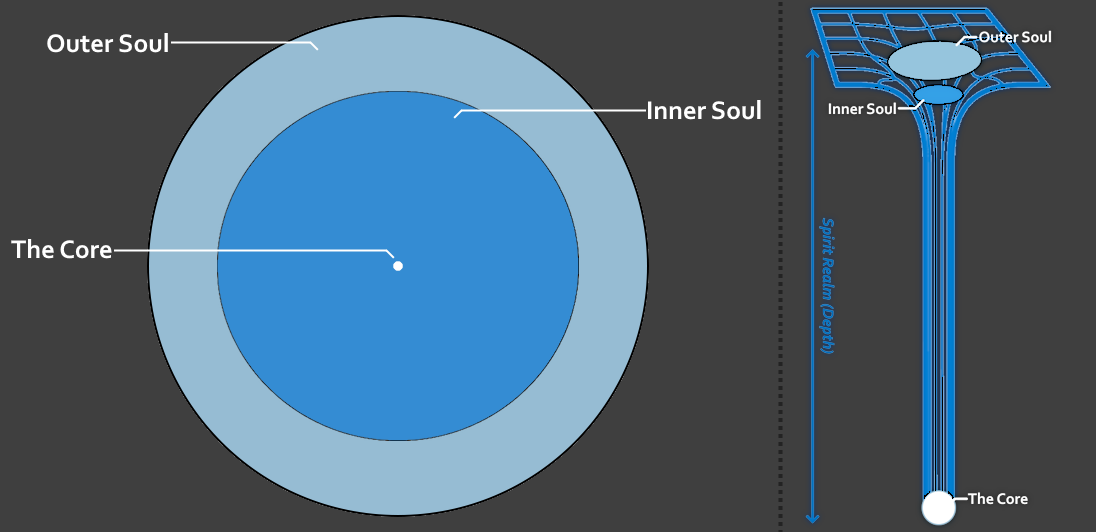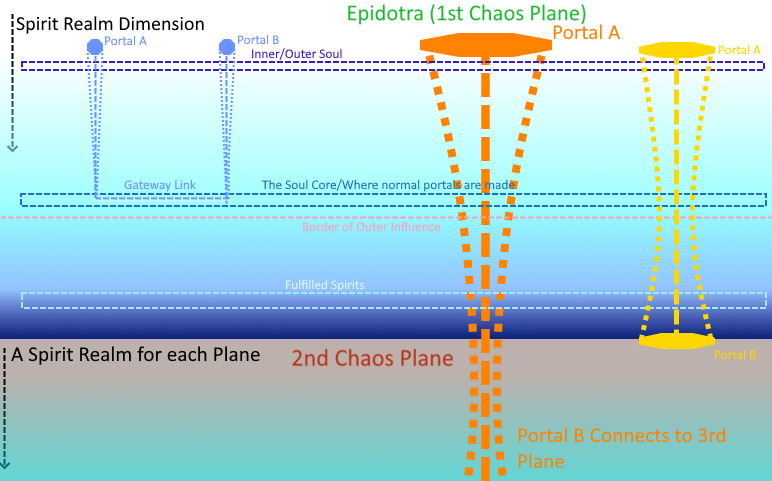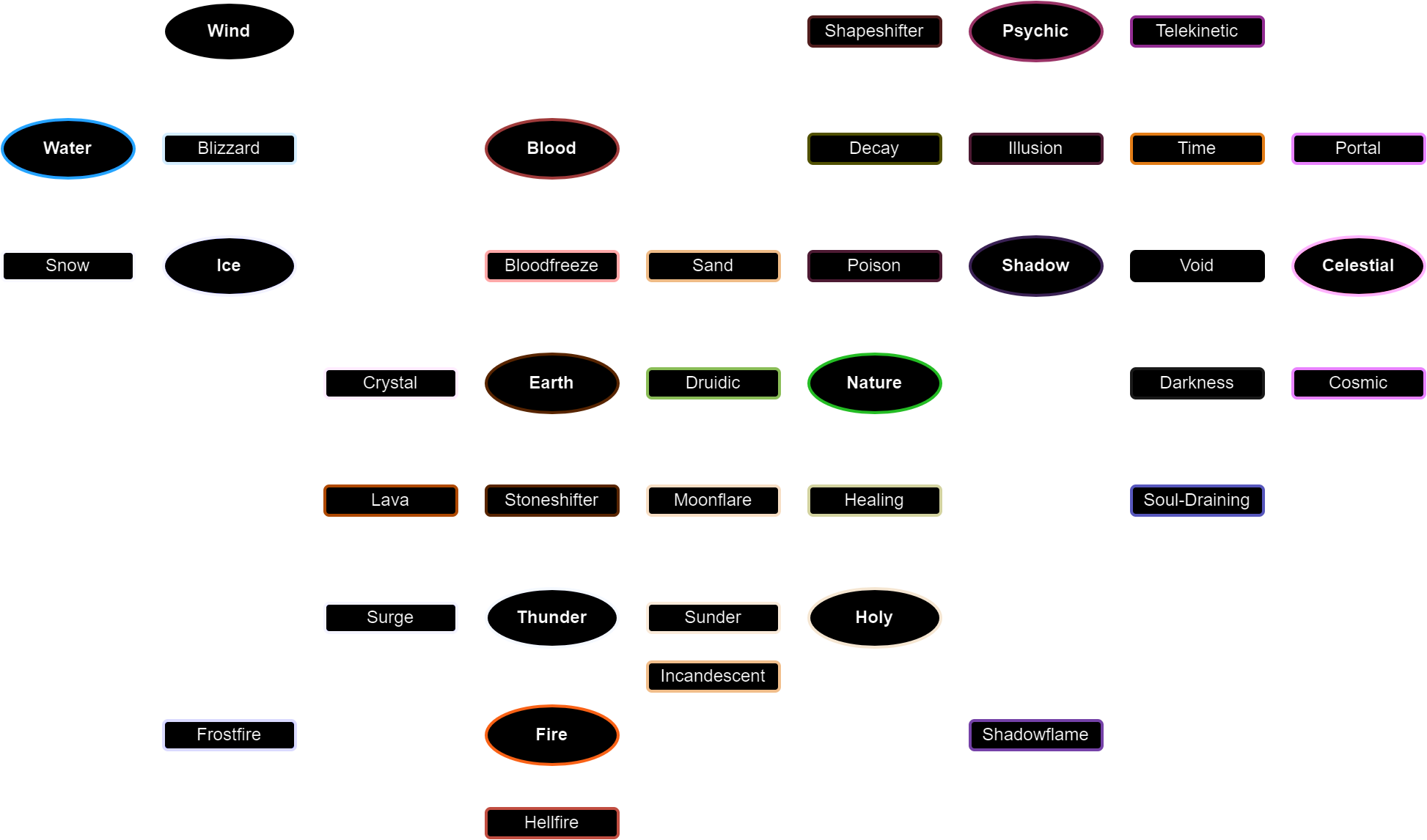The Soul
All living things to exist on Epidotra have a soul. These exist in the
Spirit Realm with layers of varying depth. The layer closest to the physical realm is known as the
Outer Soul, or Temporary Soul; further in is the
Inner Soul, or Permenant Soul; and lastly, far within the deepest known depths of the Spirit Realm is the
Core, or "Soul Point" as some refer to it.
The soul is not merely spherical in form, as its presence envelops the whole shape of the living thing it is linked to. This grants a natural resistance against magic of other creatures, and is how the soul can control the limbs of a
Skeleton for example.
Since a soul is capable of giving mobility, sight, and mind to non-living things, you may question the need for living things to have physical brains, eyes, or internal systems in the first place. To answer this: physical systems are still required for living things, as the soul does not take control while still alive. Instead, the soul learns from experiences, such as having a brain to experience thought, or muscles to walk. By undergoing these things, it allows the soul to replicate these experiences after death. Your undead self can only do what your living self has done.
A creature's soul ties them to Epidotra, the world, and as such traps them within the
thermosphere's barrier.
Willpower
All living things have an emotional range, with all ranges having a limit. A bear, a wolf, or a hen may feel sadness or anger, but only to an extent. Their soul may shrink as they mourn, or grow as they fight, yet their Willpower will not go beyond or beneath to the point of major change. Humans, however, have a much greater emotional range - far greater. Crushing despair can kill, while pure ecstasy can strengthen. Emotion is Willpower, Willpower is the Soul, the Soul is what keeps life afloat.
Magic that comes from negative emotions have been described as "sticky", being easier to imbue or "curse" objects or people. Magic from negative emotions isn't always weaker than average, as a creature may feel spite while still having a desire to live.
Soul Mutations
In extremely rare cases, a person's soul can be different than the rest. It is unknown how this occurs.
So far, only 2 soul mutations are known:
- Enhanced Willpower - This mutation causes the soul to gain strength the more damaged the physical body is. Only Zephos Dewarm & Bravo Von Vancen have this condition.
- Split Soul - A case of two entities residing in the same vessel. There is usually a "main" half, and an "other" half that awakens some point later in life, through the main half becoming unconscious. Once the other half takes control, it is not just mind that switches, but physical form too, as the other half may have different hair, magical abilities, proportions, etc. Only Holly & Joe the Bard have this condition. Joe's other half never awakened while he was alive.
Magic
Magic is a creature using a piece of their soul to affect the physical world, pulling a portion of their inner or outer soul out of the Spirit Realm and expelling it from their body; in some cases using their soul to enhance themselves.
It is very hard to learn magic, and so very rare. The average village is unlikely to have anyone proficient, and those that are only know rudimentary levels of the art.
Eventually, the normalization of magic has led to people making up popular ways of using it. As an example, it is "trendy" to give spells a name, like shouting "Fire Burst of a Thousand Suns!" when shooting a fire spell. Magic going into the Platinum Age became more of a way of showing off - a practical straightforward fireball shot is boring, while giving the fireball swirly movement makes it more interesting and shows skill in the user for how well they can use their element.
Controlling Magic
Controlling magic is akin to controlling a lucid dream.
Focus and certainty to do what you want the magic to do is foundational. For beginner mages, it helps if they close their eyes and use hand gestures as anchors, granting an easier time painting a picture of what they wish to do in their mind. Certain gestures while using magic will help tie the hand movement to the spell - as a kind of muscle memory.
Giving spells their own name is a very common tactic. Not only is it a way to make them more known - as people with named spells are more memorable - but also to help them cast the spell itself. Focusing magic is all about anchors, the most effective practice involves closing their eyes, doing a certain movement, saying the name, and being calm and controlled.
Eventually, with expert mages, the hand movements or names become second nature.
Imbuing Magic
Staves and wands contain "mana", a term referring to the outer/temporary soul, as a sort of catalyst for pre-made spells they've memorised. As long as they know what to do with the staff, or the name of the spell stored within, they'll be able to use it.
Mages may put some of their soul into a staff and use it as a magic enhancer. Most crystals are good storage for mana, therefore many staves or wands will have crystal somewhere in the design.
Defense Against Magic
If a creature were to be hit by magic, they have their own natural defense against it in the form of a soul coating that envelops them. Though a user may conjure a spell externally, they'd be unable to do so inside another creature's body assuming their soul can defend against it. Blood magic, for example, may seem deadly in its ability to control the blood of others, however a user would not be able to control another's blood as long as it is within their body and their soul can resist it. Fire users cannot implode another's body into flames without great resistance, nor can a Poison user infect another's body so simply. This is why the majority of magic combat is outward, conjuring spells to be launched at the enemy.
Gold is an insulator of magic, groups like the
Magic Guard of Anglon wear armour primarily made of gold to protect from mages.
Outer Soul
Also known as the "Temporary Soul", as imbuing it into objects will only last a short period of time. It is also regenerative but less potent than the Inner. All mages cast spells using this layer, as it is the safest to pull from.
Inner Soul
Also known as the "Permanent Soul", as imbuing it into objects will stay within them until the object is destroyed or can no longer contain it. Unlike the outer, this layer is not regenerative, so mages rarely if not ever use it. However, it is far more potent than the outer layer.
The Core
Also known as the "Soul Point", this is the very anchor for your physical form. Although most of the soul is not in any specific location inside a creature, the core is always positioned to the very origin of the creature's mass.
Teleportation
The Core is not used for any magic besides teleportation, as being able to control the location of your core will force your physical and spiritual form to move with it. This type of magic is one of the hardest to achieve, as the core lies deep in the Spirit Realm - almost nearing the depths of fulfilled spirits. It can also be dangerous if not used with utmost care. Be that as it may, Shadow users have a much easier time getting to grips with teleportation, along with it being much safer for them.
Portals
Portal creation is the hardest type of magic to achieve, as not only must the user set a "keypoint" deep enough in the Spirit Realm for the Core to pass through, but they must also construct a spiritual link between that and the other side's position. Furthermore, the portals need to be maintained - either by checking up on them and restoring them with the outer soul or sacrificing the inner soul to keep them active forever.
Portals, unfortunately, are unstable things. It is not enough to simply create a portal, as it may diffuse overtime. Proficient mages of Portal magic such as the Riftwatch build stone foundations and rings for the portals to stabilize them. These stone rings are imbued with a deep hex to stop the portal drifting or malforming.
Portals from other
Chaos Planes can appear at random and aren't manmade. Only one person has ever managed to create a portal that connects to different Chaos Planes, which was from the 2nd Plane to the 1st.
Elements
Every creature has a specific element to their soul which determines what type of magic they can use. One might have fire, another might have ice, wind, thunder, shadow, holy, etc. Rarely, humans can have two separate elements allowing them to use more than one type of magic. A human having three elements is one-in-a-million, and the only human known to have mastered four elements is the
Hallowed Knight, who is capable of using Fire, Ice, Thunder, and Earth magic.
Magical vs. Physical
Magical elements are the soul mimicking properties. This makes it not as strong as the real deal - magic fire won't spread like real fire, magic water won't quench thirst like real water, etc. Alongside everyone's body having a natural protection against magic, it makes magical combat less powerful than physical in most cases. That isn't to say physical blows will always be more effective than magical, as magic can oftentimes counter them by having the soul harden the body as an invisible armour.*
Soul's Origins
Yet no matter what element a mage casts, the soul will always be made of soul. It is a rather abstract material, nobody in Epidotra knows of its origins or how it can mimic other elements. All that is known, is that the soul is like a bottomless well of energy; a material of infinite potential, held back by the will or emotion of the creature it is tied to. A soul can theoretically become anything, of any potency. Its energy seems to pull from an endless pool of an unknown space. Is said space the Spirit Realm? We may never know, as it is not in my - the writer's - ability to explain such abstract concepts.
*Awakening the Dream
What was stated above is the norm, and what the majority of the world understands. However, sometimes this isn't always the case.
It is thought the soul is eternally dreaming, and by controlling this dream, magic can be utilised. But besides lucidity there is another aspect to dreams: vividness - dreams you are convinced are real as they happen, while you remain blind to the false reality they create. Vivid dreams are not about control like lucid, they are about bridging the gap between what is real and fake - being able to break from this illusion of realness and become fully aware, and so to "awakened the soul's dream" is to give the soul an epiphany. What becomes mimicky becomes reality, magic fire becomes equal to real, spreadable, fire; magic water becomes real, drinkable, water, etc.
Awakening the soul's dream requires a different state of mind to master, one not everyone may have, no matter how strong they are. The soul's awareness determines how complex their element can become. Folk attempt to list elements, yet the possibilities are countless, and so no matter how many categories one creates, no matter how many subcategories or subcategories of subcategories are thought of, they will never be able to list every dream of the soul.
Elemental Types
The categories made for the elements were decided by great scholars of Epidotra, and are arbitrary names. There are 12 primary elements with an indefinite quantity of subcategories - a mix of elements.
Sometimes a soul doesn't have an element, in which case it'd be considered
Arcane. Magic of this type is usually light-blue, as is the colour of the soul.
Fire
The most common type of element besides Ice. Magic fire cannot spread, however it may emit heat and so cause real fire. It also has the most subcategories:
- Incandescent - Fire & Holy - Rare, the user can create yellow holy flames. Notable users of this element are: Archon & Holy Knight.
- Hellfire - Enhanced Fire - Super rare, but more common in Demons. The flames produced are super-hot, and capable of lingering.
- Lava - Fire & Earth - Uncommon, the user can control lava. Creating lava is possible too, however it uses a lot of the soul.
- Shadowflame - Fire & Shadow - Very rare, the user can create purple flames that can burn easily. Notable users of this element are: Vepdor Raventaker, Reyner Coldtrap, & Vargo.
- Moonflare - Fire & Nature - Very rare, named after the Moonflare Bats. Properties aren't too known besides having a pinkish-orange colour. Notable users of this element are: William Cinderhelm.
- Frostfire - Fire & Ice - Rare, the user can create light-blue flames that're neither hot or cold, thus being unable to affect their surroundings. Usually used for lanterns as the brightness is above average. Notable users of this element are: Lantern-Maker Xander.
Being categories arbitrarily created by the people of Epidotra based on their knowledge, not all users with an element may be confined to a set type. An example case being
Elgas - a user of Fire magic that creates a pink flame of unknown properties. Additionally, it is believed
Emíra, the Emerald Dragon, breathed an emerald-green flame - another unique case.
Ice
The most common type besides Fire. Magic ice can reduce temperatures and cause natural frost. It's subcategories are:
- Snow - Ice & Water - Common, oftentimes mistaken for weak Blizzard magic. Users can create or control snow. Notable users of this element are: Shakadin & Erminus
- Crystal - Ice & Earth - Extremely rare, users can form crystals that may act as containers or enhancers for other magic, or be used offensively. Notable users of this element are: Shakadin
- Blizzard - Ice & Wind - Super rare, users can cause harsh temperature drops and create snow or hail. Notable users of this element are: Shakadin, Erminus, Ukko, & Calavia.
- Bloodfreeze - Ice & Blood - Extremely rare, users can freeze blood, it's in the name. Notable users of this element are: Ebony Roseberg.
- Frostfire (Shown above).
Water
A suprisingly rare element. Users can control or create water, however magic water is not drinkable. It is possible for users to use it to filter real water, as it won't control anything inside the water like dirt or parasites. Though, such things can still get stuck to the water as it is moved. Besides
Snow magic, this has no subcategories officially. Blood can very well be considered a subcategory for Water, however the people of Epidotra deemed it unique enough to be its own primary element.
Thunder
A rare element for the commonfolk, though more common for many of the stronger characters. Users can create or control lightning, a rather deadly ability due to its speed. It's subcategories are:
- Sunder - Thunder & Holy - Super rare, users can create yellow lightning. Notable users of this element are: Hallowed Knight, Asteria Pridestone, & Holy Knight.
- Surge - Enhanced Thunder - Extremely Rare. This is a much more intensive form of Thunder magic, with bolts of thick streaks. Notable users of this element are: Zephos Dewarm.
Notable users of the primary element are:
Ukko and Bravo von Vancen.
Earth
An uncommon type, users can control earth by lifting dirt and stone or molding it. Commonly used to help dig tunnels or terraform land. It's subcategories are:
- Stoneshifter - Variant Earth - Very rare, users can turn their body to stone.
- Sand - Variant Earth - Uncommon, users can control sand and cause sandstorms, along with absorbing moisture. Notable users of this element are: Rhas'tiaz.
- Druidic - Earth & Nature - Common, often mixed up with normal Nature or Earth magic.
- Lava, Crystal (Shown above).
Notable users of the primary element are:
Eaglecrest Golem, Shakadin,
Akka, &
Hallowed Knight.
Nature
An uncommon type, users can do a variety of things such as controlling plants or healing. Many refer to this element as "Druidic". It's subcategories are:
- Healing - Nature & Holy - Common, users can speed up the soul or physical body's healing process. This can mend minor injuries and sometimes cure infections, however even the more stronger healers cannot use it to perform miracles such as regenerating lost limbs, removing scars, or resurrection. Even the Demigod of Life cannot resurrect a creature once their soul becomes lost. Notable users of this element are: Tillota Pridestone, Demigod of Life, & Holy Knight.
- Poison - Nature & Blood - Rare, novice users are only able to poison liquids, such as water, and are more resistant to poisons. More advanced mages can create poisonous mist or infect their surroundings. As a side-effect, a Poison soul makes the person more frail. Notable users of this element are: Thorn, Bane of the Forest & God of Blight.
- Moonflare, Druidic (Shown above).
Notable users of the primary element are:
Alder, Warden of the Forest, Syllessa Fenric, Khekos,
Akka,
God of Blight, &
Demigod of Life.
Holy
An extremely rare type, users can create light and cause great damage to Undead and
Demons. This magic used to be a light-cyan colour during the first Demigod of Light's time, and was known as Sacred magic; now it is a light-yellow. It's subcategories are:
- Purity - Variant Holy - Uncommon, users are capable of purifying the Darkness of another, and is in general a great counter to Shadow magic. Notable users of this element are: Bella Pemont & Holy Knight.
- Incandescent, Sunder, Healing (Shown above).
Notable users of the primary element are:
Holy Knight,
Erhan, Archon,
Asteria Pridestone, &
Demigod of Life.
Shadow
A super rare type, users can conjure shadows or turn into ones. Folk with a Shadow soul are often mistrusted or shunned. It's subcategories are:
- Darkness - Variant Shadow - Common, can be considered indifferent to Shadow, users have a harder time controlling this. Notable users of this element are: Rawkin Graythorn & Daerel Foremaul.
- Soul-Draining - Variant Shadow - Very rare, the user can drain the outer soul of another. If strong enough, they can reach the inner soul, however it takes much more effort. Notable users of this element are: The Keeper, Gail, Bloodskull, the Tainted, & Ashera Roseberg.
- Void - Shadow & Celestial - Extremely rare, a much more powerful version of Shadow magic that can also alter the gravity of objects. Notable users of this element are: Nebuleus.
- Decay - Shadow & Blood - Super rare, created from the False God of Decay's will. A great counter to Nature magic. Users can cause rot, rust, or aging of objects, and if strong enough, of living things. Makes the user more prone to diseases. Notable users of this element are: Bloodskull, the Tainted, God of Decay, & God of Blight.
- Illusion - Shadow & Psychic - Common, users can create mirages of objects or themselves. These mirages can become physical. Notable users of this element are: Nebuleus, Prima Noblebreath, Khekos, & Bloodskull, the Tainted.
- Shadowflame (Shown above).
Notable users of the primary element are:
Skull Digger,
The Keeper,
Ashera Roseberg, & Gail.
Wind
A very rare type, users can create or control wind or oftentimes concentrate air into their weapon uses to cause a sharp gust. It's subcategories are:
Notable users of the primary element are:
Ukko &
Zephos Dewarm.
Blood
Extremely rare, users can manipulate blood. It's subcategories are:
- Shapeshifter - Blood & Psychic - Extremely rare, the user can morph their physical form to different shapes. Succubi are capable of this by nature.
- Bloodfreeze, Decay (Shown above).
Notable users of the primary element are:
The Keeper,
Bloodskull, the Tainted, &
Gwethyn.
Psychic
An extremely rare type, users can control physical objects, read minds, or sometimes control living things. It's subcategories are:
- Telekinetic - Variant Psychic - Common, users can control physical things, but cannot do other features of Psychic magic. Notable users of this element are: Elgas, Nebuleus, Bloodskull, the Tainted, & Holy Knight.
- Illusion, Shapeshifter (Shown above).
Notable users of the primary element are: Prima Noblebreath,
Nebuleus, &
Bloodskull, the Tainted.
Celestial
The rarest type of element. Only the
Demigods are known to have this, however there are some others. It's subcategories are:
- Cosmic - Variant Celestial - Extremely rare, associated with users conjuring stars.
- Time - Celestial & Psychic - Extinct. Epidotrian people cannot naturally get this type of magic, only the Ancient Folk can. Grants the ability to manipulate time, either to yourself to cease or slow aging or within a time bubble.
- Portal - Variant Celestial - The rarest subcategory. Only the most skillful users can create portals. Notable users of this element are: Nebuleus, & Vantorus.
- Void (Shown above).
Notable users of the primary element are:
Nebuleus,
Vantorus,
Holy Knight,
Senkard,
Death,
Demigod of Life.





Comments